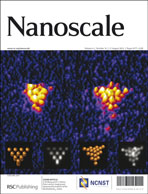Anion-controlled morphologies and spectral features of cyanine-based nanoGUMBOS – an improved photosensitizer†
Abstract
The ability to control the morphologies and spectral properties of organic low-dimensional nanomaterials is of paramount importance. The research reported herein demonstrates a template-free approach to tailored morphological and optical properties for a novel class of pseudoisocyanine (PIC)-based fluorescent organic


 Please wait while we load your content...
Please wait while we load your content...